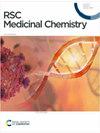Christine Katharina Maurer, Zhizhou Fang, Christina Schindler, Gianna Pohl, Fouzia Machrouhi-Porcher, Marc Lecomte, Carl Petersson and Heide Marika Duevel
求助PDF
{"title":"In vitro and in vivo ADME of heterobifunctional degraders: a tailored approach to optimize DMPK properties of PROTACs©†","authors":"Christine Katharina Maurer, Zhizhou Fang, Christina Schindler, Gianna Pohl, Fouzia Machrouhi-Porcher, Marc Lecomte, Carl Petersson and Heide Marika Duevel","doi":"10.1039/D4MD00854E","DOIUrl":null,"url":null,"abstract":"<p >Proteolysis-targeting chimeras (PROTACs©) have recently emerged as a promising new drug modality. Residing beyond the rule-of-five space, they pose challenges in terms of physicochemical properties. With this study, we contribute to enhancing the understanding of their early ADME characterization. For permeability assessment, transwell assays such as Caco-2 remain challenging. Although the addition of serum may reduce unspecific binding and improve recovery, the assay was not found predictive for absorption. As a surrogate, we propose to focus optimization on molecular descriptors and support a preferred space for oral PROTACs© with ≤3 H-bond donors (HBDs), molecular weight (MW) ≤950 Da and number of rotatable bonds ≤12. We have developed a predictive score serving as initial guidance for design and prioritization according to this property space. In addition, the reduction of exposed polar surface area, <em>e.g.</em> through shielding of HBDs, is a powerful approach to optimize permeability. Using standard small molecule-based methods for <em>in vitro</em>–<em>in vivo</em> extrapolation (IVIVE) of intrinsic clearance (CL<small><sub>int</sub></small>) with experimentally determined hepatocyte CL<small><sub>int</sub></small> and fraction unbound in plasma, and predicted fraction unbound in the incubation (<em>f</em><small><sub>u,inc</sub></small>), a systematic under-prediction from mouse hepatocytes was observed for PROTACs©. In line with our observation that the Kilford equation was not suitable for PROTAC© <em>f</em><small><sub>u,inc</sub></small> prediction, this bias could be overcome by using experimentally determined <em>f</em><small><sub>u,inc</sub></small>. Taken together, this study suggests a tailored <em>in vitro</em> DMPK discovery assay cascade and frontloading <em>in vivo</em> studies. It also underlines the need for inclusion of surrogate permeability descriptors and experimentally determined values for IVIVE of CL<small><sub>int</sub></small>.</p>","PeriodicalId":21462,"journal":{"name":"RSC medicinal chemistry","volume":" 4","pages":" 1746-1757"},"PeriodicalIF":4.1000,"publicationDate":"2025-02-21","publicationTypes":"Journal Article","fieldsOfStudy":null,"isOpenAccess":false,"openAccessPdf":"","citationCount":"0","resultStr":null,"platform":"Semanticscholar","paperid":null,"PeriodicalName":"RSC medicinal chemistry","FirstCategoryId":"3","ListUrlMain":"https://pubs.rsc.org/en/content/articlelanding/2025/md/d4md00854e","RegionNum":4,"RegionCategory":"医学","ArticlePicture":[],"TitleCN":null,"AbstractTextCN":null,"PMCID":null,"EPubDate":"","PubModel":"","JCR":"Q2","JCRName":"BIOCHEMISTRY & MOLECULAR BIOLOGY","Score":null,"Total":0}
引用次数: 0
引用
批量引用
Abstract
Proteolysis-targeting chimeras (PROTACs©) have recently emerged as a promising new drug modality. Residing beyond the rule-of-five space, they pose challenges in terms of physicochemical properties. With this study, we contribute to enhancing the understanding of their early ADME characterization. For permeability assessment, transwell assays such as Caco-2 remain challenging. Although the addition of serum may reduce unspecific binding and improve recovery, the assay was not found predictive for absorption. As a surrogate, we propose to focus optimization on molecular descriptors and support a preferred space for oral PROTACs© with ≤3 H-bond donors (HBDs), molecular weight (MW) ≤950 Da and number of rotatable bonds ≤12. We have developed a predictive score serving as initial guidance for design and prioritization according to this property space. In addition, the reduction of exposed polar surface area, e.g. through shielding of HBDs, is a powerful approach to optimize permeability. Using standard small molecule-based methods for in vitro –in vivo extrapolation (IVIVE) of intrinsic clearance (CLint int f u,inc f u,inc f u,inc in vitro DMPK discovery assay cascade and frontloading in vivo studies. It also underlines the need for inclusion of surrogate permeability descriptors and experimentally determined values for IVIVE of CLint
异功能降解物的体内和体外ADME:一种优化PROTACs DMPK特性的定制方法©。
靶向蛋白水解嵌合体(PROTACs©)最近成为一种有前途的新型药物模式。它们超越了五法则的空间,在物理化学性质方面提出了挑战。通过这项研究,我们有助于提高对其早期ADME特征的理解。对于渗透率评估,Caco-2等井间分析仍然具有挑战性。虽然添加血清可以减少非特异性结合并提高回收率,但该分析不能预测吸收。作为替代,我们建议重点优化分子描述符,并支持口服PROTACs©具有≤3个氢键供体(HBDs),分子量(MW)≤950 Da,可旋转键数≤12个的首选空间。我们已经开发了一个预测分数,作为根据这个属性空间设计和优先级的初步指导。此外,减少暴露的极性表面积,例如通过屏蔽hbd,是优化渗透率的有效方法。使用标准的基于小分子的体外外推(IVIVE)方法,利用实验测定的肝细胞内清除率(CLint)和血浆中未结合的部分,以及在孵育过程中预测的未结合部分(f等),观察到来自小鼠肝细胞对PROTACs的系统性预测不足©。根据我们的观察,Kilford方程不适合PROTAC©f,inc预测,这种偏差可以通过使用实验确定的f,inc来克服。综上所述,本研究提出了一种量身定制的体外DMPK发现实验级联和体内前负荷研究。它还强调需要包含替代渗透率描述符和实验确定的CLint的IVIVE值。
本文章由计算机程序翻译,如有差异,请以英文原文为准。

 求助内容:
求助内容: 应助结果提醒方式:
应助结果提醒方式:


